
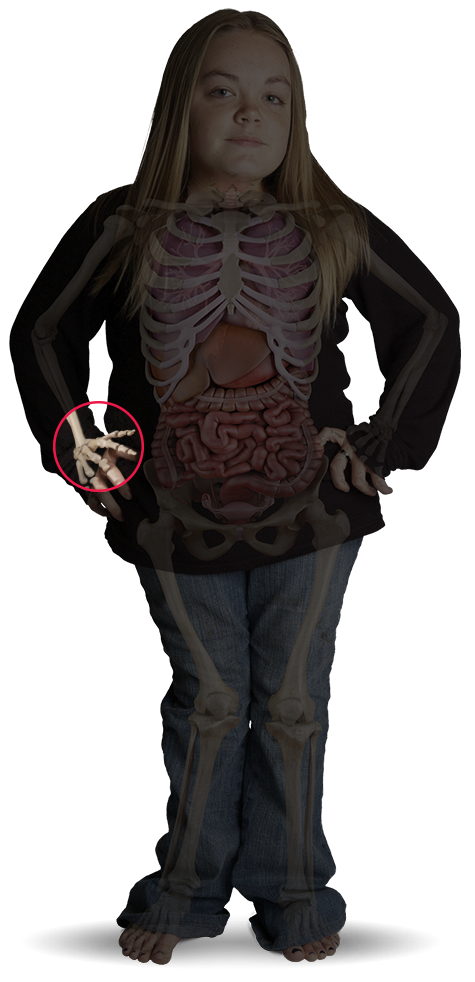
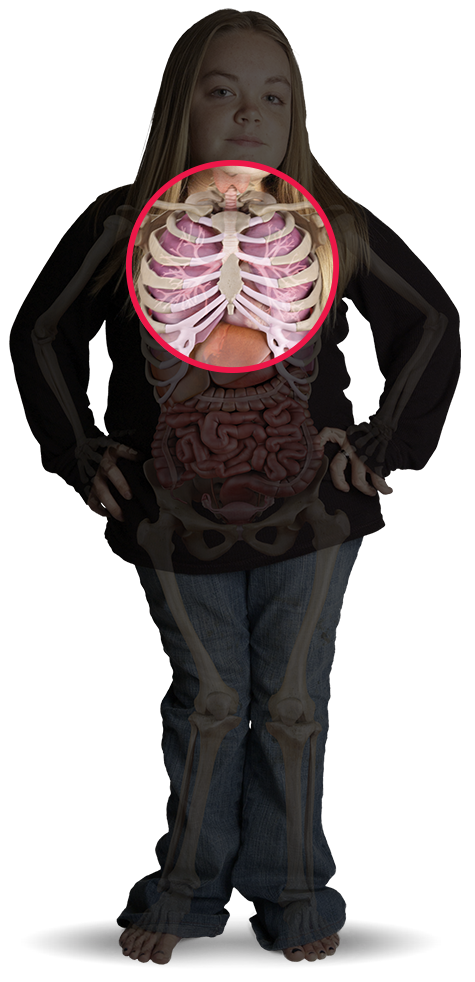

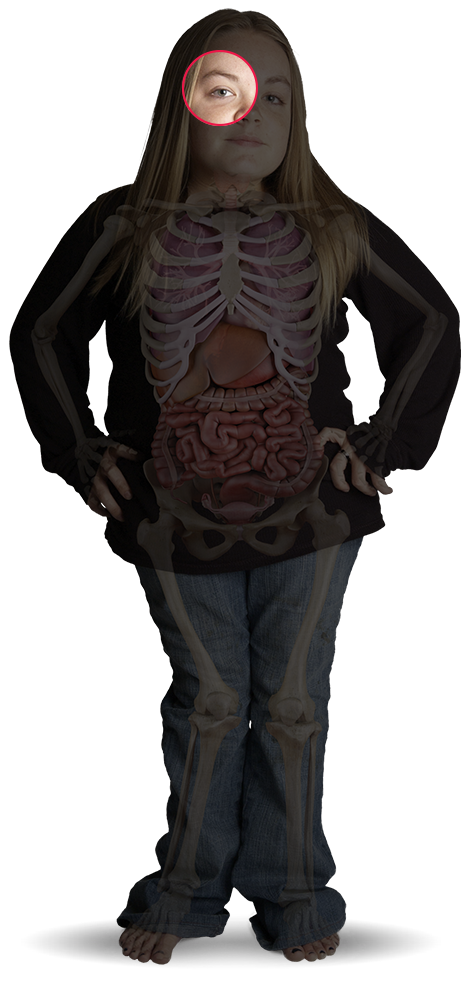
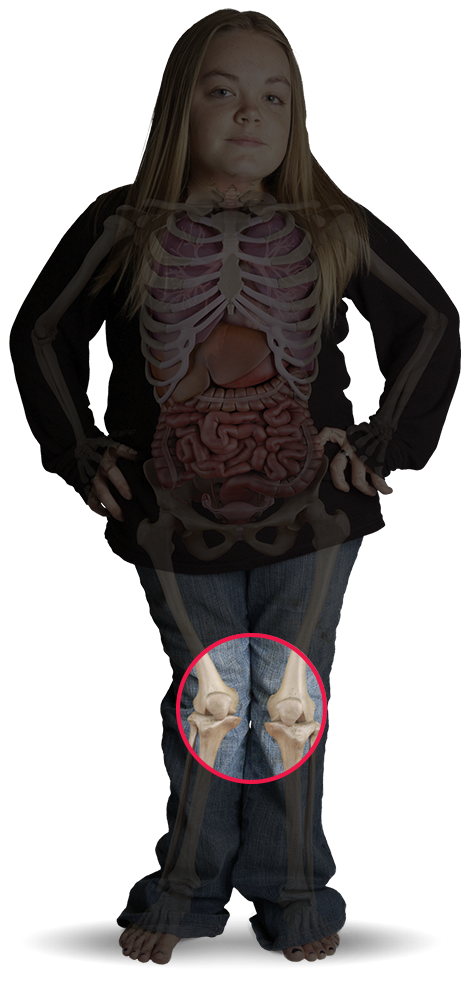
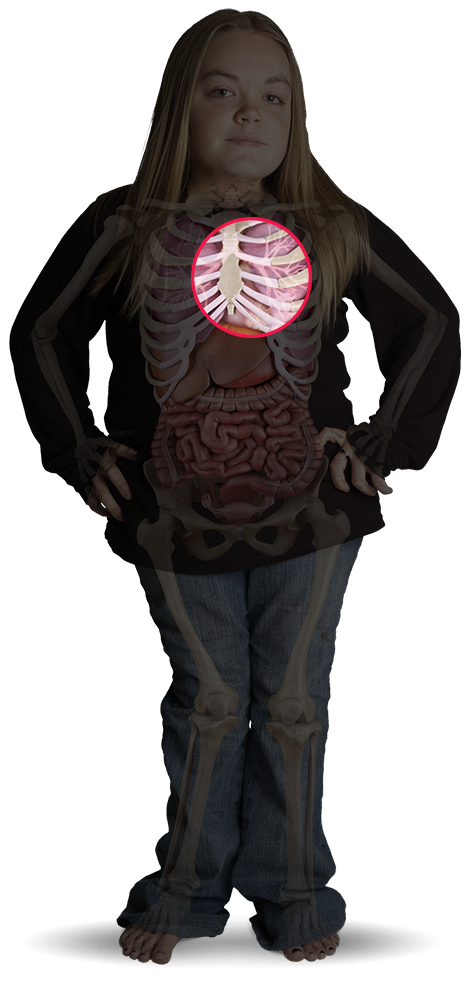
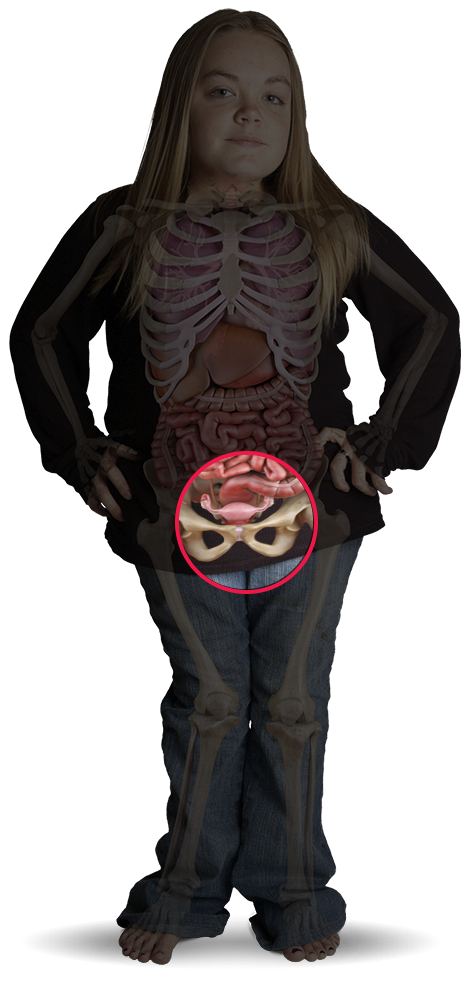




















Neurologic involvement is common in individuals with mucopolysaccharidosis (MPS) and may constitute some of the first presenting symptoms of disease. It is important for neurology to consider MPS in a variety of presentations, as patterns of neurologic involvement vary substantially by MPS subtype. MPS may present with or without intellectual disability and, for some subtypes, central nervous system involvement is primarily due to cervical spinal subluxation and cord compression.1-3
Along with these common neurologic signs and symptoms, the following should also raise your index of suspicion for MPS1:
Nuclear magnetic resonance image of a patient with MPS showing marked supratentorial hydrocephalus.
Courtesy of Dr Grimaldi M. and Dr Parini R. (Monza).
Nuclear magnetic resonance image of the craniocervical junction with the head in neutral position (left) and with flexion of the head towards the neck (right), showing reduction in the diameter of the vertebral canal at the craniocervical junction with consequent compression of the spinal cord.
Courtesy of Dr Grimaldi M. and Dr Parini R. (Monza).
Respiratory symptoms are commonly seen in individuals with mucopolysaccharidosis (MPS) and may lead to an MPS diagnosis. Airway obstruction and respiratory impairment are prominent features of MPS and may progress early in the course of the disease.1
Respiratory disorders are prevalent across most MPS types and have a variety of manifestations, including narrow airways and sleep-disordered breathing.2
Along with these common respiratory signs, the following should also raise your index of suspicion for MPS:
Radiograph image of the anteroposterior chest in an 11-year-old female patient with MPS VI showing thick but not paddle-shaped ribs and thick clavicles.
Source: Skeletal Radiology, volume 43, issue 3. Lachman RS, Burton BK, Clarke LA, Hoffinger S, Ikegawa S, Jin D-K, Kano H, Kim O-H, Lampe C, Mendelsohn NJ, Shediac R, Tanpaiboon P, White KK. Mucopolysaccharidosis IVA (Morquio A syndrome) and VI (Maroteaux-Lamy syndrome): under-recognized and challenging to diagnose. Pages 359-369. Copyright (C) Lachman RS, Burton BK, Clarke LA, Hoffinger S, Ikegawa S, Jin D-K, Kano H, Kim O-H, Lampe C, Mendelsohn NJ, Shediac R, Tanpaiboon P, White KK 2014.
Multidetector computed tomography scans of the trachea in patients with MPS.
Courtesy of Dr Grimaldi M. and Dr Parini R. (Monza).
Ear, nose, and throat (ENT) manifestations are commonly seen in individuals with mucopolysaccharidosis (MPS) and are often among the first symptoms to appear. Common manifestations include but are not limited to adenotonsillar hypertrophy, frequent infections of the upper airway, and hearing loss.1,2
Any number of ENT symptoms, especially if coupled with other systemic signs and symptoms, should prompt referral to a geneticist or metabolic center.3,4 Along with the common ENT and respiratory signs, these additional features should also raise your index of suspicion for MPS5:
Computed tomography scan of the ear of a patient with MPS.
Courtesy of Dr Grimaldi M. and Dr Parini R. (Monza).
Ocular manifestations often arise prior to other features of mucopolysaccharidosis (MPS) and vary by type and severity among the MPS disorders. Corneal clouding is a hallmark feature of MPS.1
Ocular features—often leading to visual impairment—have been described in all types of MPS and should raise suspicion of MPS.
Common ocular manifestations include the following2:
Bone- and joint-related features are common from a very early stage of disease in patients with most types of mucopolysaccharidosis (MPS) disorders. Patients with these types of musculoskeletal manifestations often present to a rheumatologist—and often before MPS is diagnosed.1
Rheumatologic involvement is uniformly progressive, with incidence and severity increasing over time. Although patients with MPS typically present with a wide range or cluster of symptoms, isolated symptoms may be sufficient to merit referral to a geneticist or metabolic center.1,2
Signs and symptoms may be subtle or overt. Common bone and joint features suggestive of MPS include the following1:
Rheumatologists should additionally consider an MPS referral in patients with any of the following:
Manifestations of dysostosis multiplex in the hands. Radiograph showing hands of a patient with MPS in early childhood, with moderately severe proximal pointing and expanded metacarpals with thin cortices.
Reproduced with permission from Lachman, J Pediatr Rehabil Med, 2010.
Radiograph of anteroposterior pelvis and hips in a 27-year-old patient with Morquio A showing mildly dysplastic capital femoral epiphysis with joint space narrowing and sclerosis (degenerative arthrosis).
Source: Skeletal Radiology, volume 43, issue 3. Lachman RS, Burton BK, Clarke LA, Hoffinger S, Ikegawa S, Jin D-K, Kano H, Kim O-H, Lampe C, Mendelsohn NJ, Shediac R, Tanpaiboon P, White KK. Mucopolysaccharidosis IVA (Morquio A syndrome) and VI (Maroteaux-Lamy syndrome): under-recognized and challenging to diagnose. Pages 359-369. Copyright (C) Lachman RS, Burton BK, Clarke LA, Hoffinger S, Ikegawa S, Jin D-K, Kano H, Kim O-H, Lampe C, Mendelsohn NJ, Shediac R, Tanpaiboon P, White KK 2014.
Cardiac involvement is commonly seen in individuals with mucopolysaccharidosis (MPS) and leads to extensive morbidity and, potentially, premature mortality. Early suspicion is therefore critical, regardless of whether cardiac symptoms are seen alone or in combination with other symptoms.1
The most common cardiac findings in MPS, as reported in an evaluation of 28 patients aged 2 to 14 years were1
Along with the preceding common cardiac signs, the following signs should raise your index of suspicion for MPS:
Courtesy of Dr Russo P. and Dr Parini R. (Monza).
Courtesy of Dr Russo P. and Dr Parini R. (Monza).
Classically, mucopolysaccharidosis (MPS) is associated with a cluster of signs and symptoms referred to as dysostosis multiplex, with the exception of MPS III. However, recognition of early and nonclassic skeletal symptoms prior to more robust skeletal progression can enable early recognition, and should prompt referral to a geneticist or metabolic center.1
Most MPS types are characterized by skeletal abnormalities and joint disease with hallmark features of dysostosis multiplex.1,2
Radiograph image showing dysostosis multiplex manifestations in the pelvis and hips of a patient with MPS. Rounded iliac wings, double-contoured ileal lateral walls (arrows), and elongated femoral necks.
Reproduced with permission from Lachman, J Pediatr Rehabil Med, 2010.
Radiograph of the chest of a patient with MPS showing paddle-shaped ribs and short thickened clavicles (arrows).
Reproduced with permission from Lachman, J Pediatr Rehabil Med, 2010.
Radiograph of anteroposterior pelvis and hips in a 27-year-old patient with Morquio A showing mildly displastic capital femoral epiphysis with joint space narrowing and sclerosis (degenerative arthrosis).
Source: Skeletal Radiology, volume 43, issue 3. Lachman RS, Burton BK, Clarke LA, Hoffinger S, Ikegawa S, Jin D-K, Kano H, Kim O-H, Lampe C, Mendelsohn NJ, Shediac R, Tanpaiboon P, White KK. Mucopolysaccharidosis IVA (Morquio A syndrome) and VI (Maroteaux-Lamy syndrome): under-recognized and challenging to diagnose. Pages 359-369. Copyright (C) Lachman RS, Burton BK, Clarke LA, Hoffinger S, Ikegawa S, Jin D-K, Kano H, Kim O-H, Lampe C, Mendelsohn NJ, Shediac R, Tanpaiboon P, White KK 2014.
Regardless of the clinical setting, there are overt and generally observable signs that should raise your suspicion of mucopolysaccharidosis (MPS) disorders, including1-18
Consideration of MPS based on suspicious patterns of signs and symptoms is the first step to arriving at a definitive diagnosis of a specific MPS disorder. Of particular importance, recognition of the heterogeneous nature of slowly progressive disease is essential to reduce time to diagnosis for many patients.3